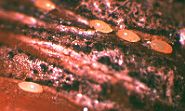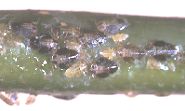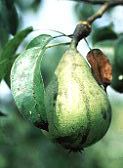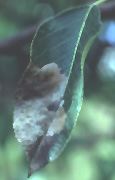Hello, everyone,
At yesterday's vineyard IPM workshop n Madison County, vines were at bud swell. This is a key time for a couple of pests.
Grape flea beetle adults feed on primary buds at this time. This is mainly a problem in parts of blocks near wooded edges - but in such rows I have seen 40% of the primary buds destroyed. This is a metallic blue-green beetle that is almost 5 mm long. Adults overwinter in debris in and near the vineyard. They become active early in the spring and lay eggs in cracks in the bark, at bases of buds, between bud scales, and on leaves. Eggs are light yellow and are laid in masses; they hatch in a few days and larvae feed on grape leaves for 3-4 weeks. Larvae are brown with black spots, and reach a length of 10 mm. Larval feeding damage consists of characteristic chain-like feeding marks on leaves, although occasionally this injury may appear more extensive. However, the damage by adult grape flea beetles is more important. The beetles eat holes into the sides of buds and gouge out the contents as the buds swell. Such injury occurs most prominently on thick-leaved grapes which have large buds, such as the American cultivars `Concord' and `Niagara'. It should be noted that climbing cutworms can cause similar damage. However, damage by the latter pest complex is usually more ragged in appearance. Adults also feed on the unfolding leaves. For more information, visit http://www.virginiafruit.ento.
Climbing cutworms also attack primary buds, but injury can be more generally distributed throughout the block.
The biology of the various climbing cutworms varies considerably but the peak flight periods and generations for some of the common species are listed above. The most common species have one or two generations per year and overwinter as half-grown larvae on the soil in leaf litter and orchard debris. A few other species overwinter as eggs or even as adults. The species which overwinter as larvae begin to become active as the weather warms, generally in mid-April. This group of moths derives its name from the larval habit of climbing trees to feed on buds and young foliage during the night, and then crawling back down to the ground to seek shelter under leaf litter, killed grass, or debris on the vineyard floor during the day. The larvae often curl up tightly when disturbed. Hundreds of larvae may feed on a single tree. The larvae mature by May and enter the soil to construct pupal chambers. In two-generation species, second generation feeding is minor.
Most injury from climbing cutworms occurs in the spring when they feed on primary buds or young shoots. In severe cases, all buds may be killed, so that growth is delayed considerably compared to uninjured cordons. While growth will likely resume later from secondary or tertiary buds, yield from such shoots is reduced, and harvest maturity is erratic, especially when considering bunches produced on other, uninjured vines. For more information, visit http://www.virginiafruit.ento.
More later,
Doug
At yesterday's vineyard IPM workshop n Madison County, vines were at bud swell. This is a key time for a couple of pests.
Grape flea beetle adults feed on primary buds at this time. This is mainly a problem in parts of blocks near wooded edges - but in such rows I have seen 40% of the primary buds destroyed. This is a metallic blue-green beetle that is almost 5 mm long. Adults overwinter in debris in and near the vineyard. They become active early in the spring and lay eggs in cracks in the bark, at bases of buds, between bud scales, and on leaves. Eggs are light yellow and are laid in masses; they hatch in a few days and larvae feed on grape leaves for 3-4 weeks. Larvae are brown with black spots, and reach a length of 10 mm. Larval feeding damage consists of characteristic chain-like feeding marks on leaves, although occasionally this injury may appear more extensive. However, the damage by adult grape flea beetles is more important. The beetles eat holes into the sides of buds and gouge out the contents as the buds swell. Such injury occurs most prominently on thick-leaved grapes which have large buds, such as the American cultivars `Concord' and `Niagara'. It should be noted that climbing cutworms can cause similar damage. However, damage by the latter pest complex is usually more ragged in appearance. Adults also feed on the unfolding leaves. For more information, visit http://www.virginiafruit.ento.
Climbing cutworms also attack primary buds, but injury can be more generally distributed throughout the block.
The biology of the various climbing cutworms varies considerably but the peak flight periods and generations for some of the common species are listed above. The most common species have one or two generations per year and overwinter as half-grown larvae on the soil in leaf litter and orchard debris. A few other species overwinter as eggs or even as adults. The species which overwinter as larvae begin to become active as the weather warms, generally in mid-April. This group of moths derives its name from the larval habit of climbing trees to feed on buds and young foliage during the night, and then crawling back down to the ground to seek shelter under leaf litter, killed grass, or debris on the vineyard floor during the day. The larvae often curl up tightly when disturbed. Hundreds of larvae may feed on a single tree. The larvae mature by May and enter the soil to construct pupal chambers. In two-generation species, second generation feeding is minor.
Most injury from climbing cutworms occurs in the spring when they feed on primary buds or young shoots. In severe cases, all buds may be killed, so that growth is delayed considerably compared to uninjured cordons. While growth will likely resume later from secondary or tertiary buds, yield from such shoots is reduced, and harvest maturity is erratic, especially when considering bunches produced on other, uninjured vines. For more information, visit http://www.virginiafruit.ento.
More later,
Doug




